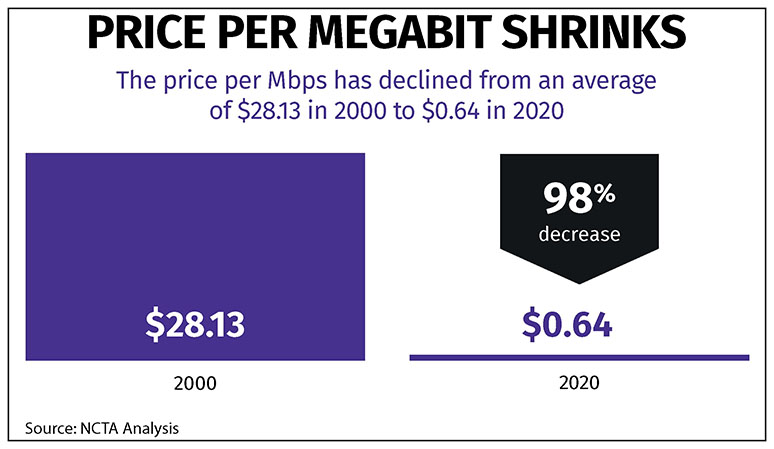During difficult times, like the pandemic we’ve just endured, it is comforting to have a service we can rely on. A service that brings us together, informing and entertaining while allowing the vital work and education that sustain our economy to continue. That service, of course, is broadband.
Here’s the good news: with each passing year, broadband is getting faster, cheaper, and more widely available. And although we still have a way to go to ensure that every American has access to the power of broadband, it is worth taking a moment to look at how far we’ve come.
From megabits to gigabits
Think back to the state of the internet just 10 to 20 years ago. In the 2000s, it could take an hour or more to download a movie; today, numerous streaming services are available on our computers, TVs, and phones at the touch of a button. In 2008, for example, just 15% of American households had internet speeds of 10 megabits per second. Today, in contrast, over 80% of homes across the country have access to speeds in the gigabits – that is, a thousand megabits. And this revolution of internet speed was so quiet and quick that we mostly took for granted.
As speeds have increased, consumer value has improved as well. While in 2000, the price per megabit of service was over $28 dollars, yet with exponential speed increases the price by 2020 had dropped to $0.64 per Mbps – a 98% decrease in two decades. This ever-improving combination of price and value not only means that more people have broadband access, but also that access to higher-quality content, from HD movies to interactive gaming to Zoom calls with hundreds of people. And with 10G internet – meaning speeds of 10 Gbps – just around the corner, this is just the tip of the iceberg of what will be available over the decade to come.

Investment and satisfaction
These impressive improvements in speed and cost didn’t come out of nowhere, but instead are the fruit of the sustained investment of the broadband industry. Over the last 20 years, total broadband infrastructure investment has reached $2 trillion and it has provided important economic windfalls for our communities, creating three million direct and indirect jobs.
In general, consumers like what they see. According to an April 2021 survey by the NCTA – The Internet & Television Association, 86% of customers have been satisfied with their home internet service during COVID-19, rating it excellent or good. A further 84% are satisfied with internet speeds and security, with 82% approving of the signal strength and reliability of their service. Crucially, 73% of adults are confident that broadband providers will continue to improve to meet future needs, with strong majorities favoring broadband specific governmental initiatives to expand internet access.
The work that remains
All of this is good news, but there is still work to be done. Today, 5% of Americans still cannot access high-speed internet at home, many of them living in rural areas that are more difficult to connect. And even in areas where the infrastructure exists, many more homes have not been able to benefit from it. Indeed, when schools closed at the beginning of the pandemic, some 10 million students – overwhelmingly lower-income and students of color – had to tackle the challenges of distance learning without internet in their homes.
Fortunately, both the Federal Communications Commission and the broadband industry are working to close this “digital divide”. For instance, a new federal Emergency Broadband Benefit Program will allow eligible households the opportunity to receive discounts on both broadband service and the purchase of a desktop, laptop, or tablet. There are many ways to qualify, and registration is easy. To find out more about how you can participate, read our related article here.
